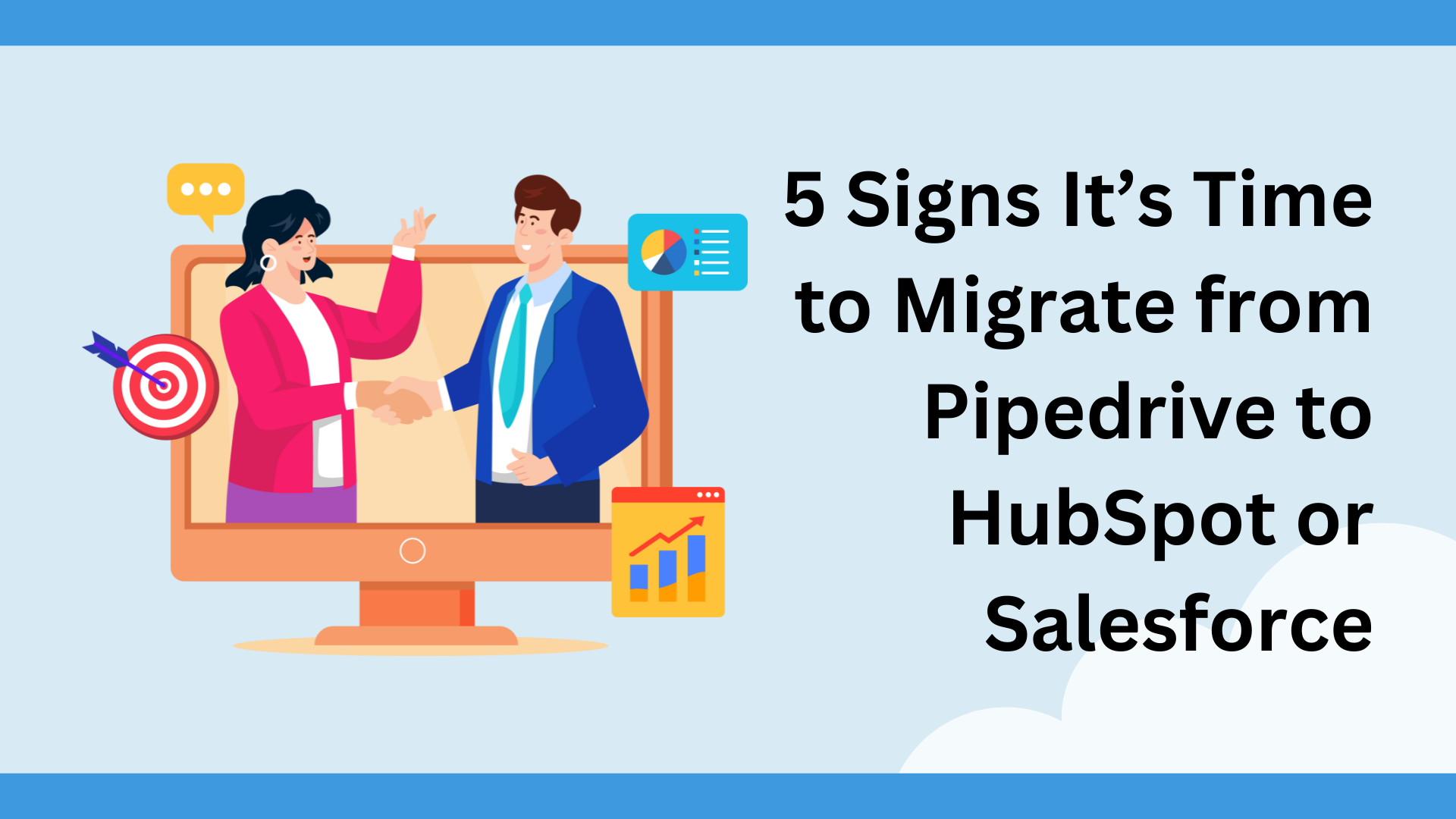If your B2B growth is hitting a ceiling and Pipedrive isn’t cutting it, exploring a Pipedrive to HubSpot migration (or Salesforce) could be a game-changer. Before jumping, here are five clear signals it's time to evaluate a switch.
1. You’ve Outgrown Pipedrive’s Sales-First Simplicity
Pipedrive is praised for its straightforward, sales-focused pipelines, especially for teams under ~20 reps. It earned a high 4.2/5 usability score in competitive comparisons (reddit.com+11avoma.com+11coefficient.io+11). But when marketing, service, and ops workflows start getting traction, Pipedrive shows its limits—it lacks the depth of automation and integrated tools native to bigger platforms.
By contrast, leaders like HubSpot and Salesforce offer full-stack ecosystems that blend CRM with marketing automation, help desk, reporting, and more. This is a core difference in HubSpot vs Pipedrive debates—HubSpot may be more complex, but it’s scalable .
2. You’re Chasing Automation and Cross-Team Alignment
A common driver behind CRM migration services is bottlenecks—manual handovers, data silos, disjointed customer experiences.
Pipedrive has solid automation for basic reminders and deal movements. But when workflow requirements become multi-step—like lead scoring triggers, routing, nurturing paths, and inter-department handoffs—platforms like HubSpot or Salesforce shine. Their native automation tools and deeper integrations eliminate adapter layers and reduce friction.
This gap pushes many teams to consider a Pipedrive to HubSpot migration, unlocking smarter, unified workflows that dramatically scale with your business.
3. Your Reporting Dashboard Feels Too Basic
Pipedrive delivers simple, digestible dashboards ideal for early teams. But as data needs grow—especially in marketing or support—its reporting often feels limiting.
HubSpot, on the other hand, provides advanced analytics across Sales, Marketing, Service, and Ops hubs on a single data model. Meanwhile, Salesforce offers enterprise-grade BI via Tableau. If your team needs multi-dimensional dashboards, cohort analysis, or attribution modeling, migrating is usually worth it.
4. You’re Paying for Add-Ons to Compensate
“Pipedrive + GoToWebinar + Mailchimp + Zapier” can fill gaps—but at what cost?
Once you stitch these tools together, you're effectively running lightweight CRM middleware. That’s where CRM migration services come in—offering a streamlined alternative. HubSpot and Salesforce bundle these capabilities natively, reducing maintenance, lowering app sprawl, and keeping licensing simpler.
Zapier’s comparison suggests that while Pipedrive integrates with 300+ apps, HubSpot supports 800+ natively (resultify.com+2instrumental.net+2coefficient.io+2syncmatters.com+1instrumental.net+1zapier.com). That deeper integration network is invaluable as you scale.
5. You’re Planning to Expand or Launch Verticals Soon
Growth plans—entering new markets, verticalizing offerings, or acquiring new teams—quickly expose CRM rigidity.
Pipedrive works, but lacks built-in structures like custom objects, revenue reporting, tax handling, or enterprise process orchestration. That's why so many teams research Pipedrive to HubSpot migration, or even pivot to Salesforce for its flexible schema and partner network.
HubSpot’s investments in vertical CRM and operations hub strategies mean you're not just getting more tools—you’re investing in a CRM built for scale.
Bonus: What to Expect from a Pipedrive to HubSpot Migration
Migrating CRMs isn’t plug-and-play. It requires planning, data mapping, selection of migration tools, and likely help from CRM migration services.
A typical Pipedrive to HubSpot migration process includes:
- Data evaluation & clean-up (contacts, deals, notes, custom fields) (spotdev.co.uk)
- Mapping fields between systems—using tools like Import2, MigrateMyCRM, or native HubSpot tools (knowledge.hubspot.com+8spotdev.co.uk+8syncmatters.com+8)
- Export and import cycles, followed by de-duplication and validation
- Setting up integrations, automations, and aligning workflows
- Training and change management to operationalize adoption (knowledge.hubspot.com+13spotdev.co.uk+13coefficient.io+13)
Platforms often take 24–48 hours to move via import tools (spotdev.co.uk+2support.pipedrive.com+2community.pipedrive.com+2).
For teams looking to minimize risk and focus on execution, paid CRM migration services can take the lead—mapping, migrating, and handling validations with minimal disruption.
HubSpot vs Pipedrive: Final Takeaway
- Pipedrive remains excellent for small, sales-only teams that prioritize simplicity, affordability, and pipeline clarity.
- But once you outgrow basic workflows, seek automation, invest in multi-team alignment, or need better reporting—Pipedrive begins to feel restrictive.
- That’s when a Pipedrive to HubSpot migration or even evaluating Salesforce enters the conversation.
Investing in a migration—supported by CRM migration services—can unlock agility, automation, and true operational scale. You’ll get unified data, smarter workflows, deeper pipeline visibility, and above all, more trust in your customer lifecycle.
When growth meets complexity, the path forward isn’t sticking to a tool—it’s upgrading to a platform that grows with you.





Leave a Comment